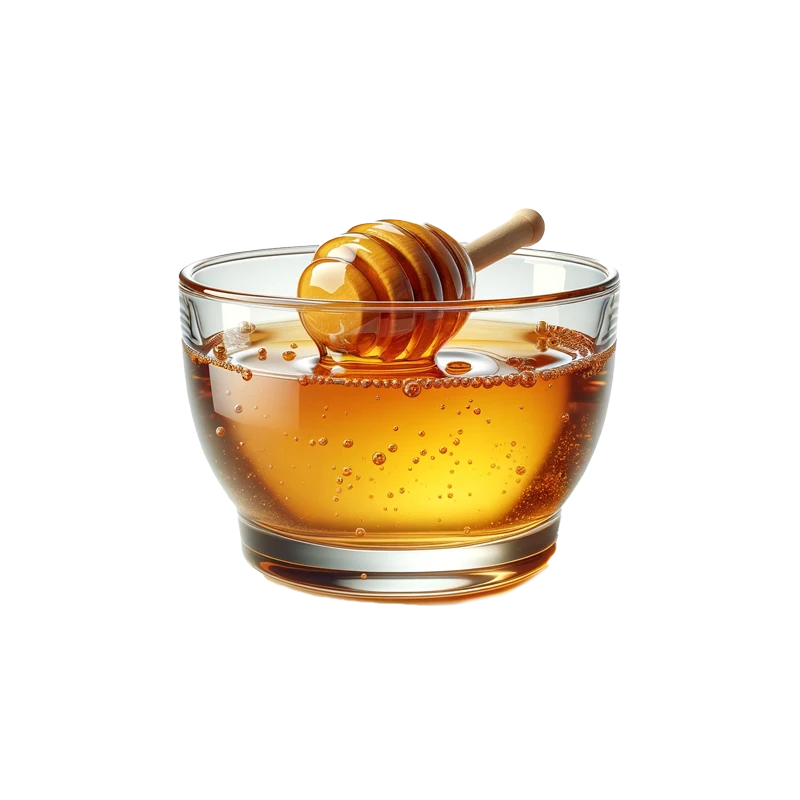Honey — Nutrients, Health Benefits, and Shopping Tips

Written by Listonic Team
Last update on September 4, 2024
Nutrition facts
Nutrition facts
Amount per 100 g
Calories
🔥 304 kcal
| Nutrients per: 100 g | Value | % Daily Value* |
|---|---|---|
| Carbs | 82 g | 29.82% |
| Fiber | 0 g | - |
| Sugars | 82 g | 164% |
| Glycemic Index | 58 | - |
| Protein | 0 g | - |
| Sodium | 4 mg | 0.17% |
| Total Fat | 0 | - |
*The % of Daily Value (DV) tells you how much a nutrient in a serving of food contributes to a daily diet. 2,000 calories a day is used for general nutrition advice.
Did you know?
Health benefits
- Rich in antioxidants such as phenolic compounds, which help protect the body from free radicals and reduce inflammation.
- Natural antibacterial and antifungal properties, which can help fight infections and support immune function.
- Soothes sore throats and can act as a natural cough suppressant.
- Provides quick energy from natural sugars, making it a good source of fuel.
- Contains trace amounts of vitamins and minerals such as Vitamin C, calcium, and iron.
Health risks
- High sugar content which can contribute to weight gain, tooth decay, and increased risk of diabetes when consumed frequently.
- High calorie content which can contribute to weight gain if consumed in large quantities, especially as a sweetener or in desserts.
- Risk of botulism particularly in infants under one year old, as honey can contain Clostridium botulinum spores, which can be harmful to babies.
- Potential for allergic reactions in individuals allergic to pollen or bee products, causing symptoms like itching, swelling, or difficulty breathing.
How to choose honey
Honey should be clear and smooth, ranging in color from light amber to dark brown based on its source. The texture should be thick and drip slowly from a spoon, not watery or crystallized unless specifically raw and unfiltered.
Avoid honey that has a gritty texture or appears overly foamy at the top, as these can indicate fermentation or dilution. Quality honey should taste sweet and floral, with subtle differences reflecting its floral origin.

How to store honey
Honey should be stored at room temperature in a tightly sealed jar. Keep it in a cool, dry place to preserve its natural flavor and consistency. Properly stored honey remains fresh and ready for use.
Exposing honey to moisture can cause it to ferment. It’s best to avoid storing it near heat sources, as high temperatures can degrade its quality. Maintaining a stable, cool environment ensures its long-term preservation and taste.
✅ Extra Tip
How long does it last?
Honey can last indefinitely when stored in a cool, dark place. It may crystallize over time, but this does not affect its quality. To return it to a liquid state, gently warm the container in warm water.
What to do with leftovers?
Leftover honey can be used in a variety of sweet and savory dishes. Drizzle it over yogurt, oatmeal, or pancakes for a natural sweetener, or mix it into salad dressings with olive oil and vinegar for a sweet-tangy flavor. Honey is also great in baking, where it adds moisture and sweetness to cakes, muffins, or bread.
Use honey as a glaze for meats like chicken or pork, where it caramelizes beautifully when roasted or grilled. If you have a lot of honey, consider making a batch of homemade granola with oats, nuts, and dried fruits. Honey can also be stirred into tea or coffee as a natural sweetener, or mixed with mustard and herbs for a honey mustard sauce to serve with vegetables or as a dipping sauce. For a quick snack, enjoy honey spread on toast with butter, or mix it into a bowl of fresh fruit for added sweetness.
👨⚕️️ Medical disclaimer
How honey supports specific health conditions
Honey is a natural sweetener rich in antioxidants, supporting immune health by protecting cells from oxidative damage. Its antibacterial properties promote wound healing and may support digestive health by balancing gut bacteria. Honey also soothes sore throats and can be used as a natural remedy for cold and flu symptoms.
However, due to its high sugar content, it should be consumed in moderation to maintain blood sugar control and weight management.
Discover products from other categories
Listonic Team
Fact-checked
Our editorial team checked this article to make sure it was accurate at the time of publishing it.
Get the top-rated shopping list app







